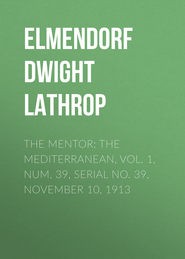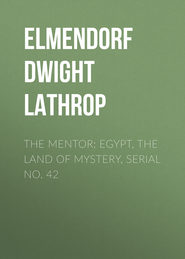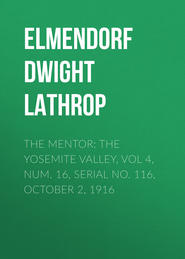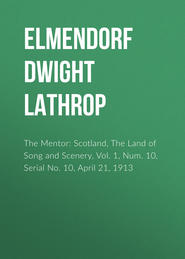По всем вопросам обращайтесь на: info@litportal.ru
(©) 2003-2024.
✖
The Mentor: Holland, v. 2, Num. 6, Serial No. 58
Настройки чтения
Размер шрифта
Высота строк
Поля
Paul Potter, called the “Raphael of animal painters,” was born in 1625, and died from overwork at the age of twenty-nine. It is said that he painted portraits of animals, and tried to know the character of every beast that he drew.
Jan Steen painted all sorts of subjects, – chemists in their laboratories, card parties, marriage feasts, religious subjects, and especially children. Besides being a successful artist, he was a brewer at Delft. He failed in this business and opened a tavern. Hence he has often been called “the jolly landlord of Leyden.”
Pieter de Hooch was the most neglected of all Dutch painters; yet in 1876 the Berlin Museum paid $26,000 for one of his paintings. He was born in Rotterdam about 1630, and became one of the most charming painters of homely subjects that Holland has produced. He died at Haarlem about 1681.
Meyndert Hobbema was born in Amsterdam about 1638, and was buried there in a pauper’s grave in 1709. Although today he is considered one of the great landscape painters of Holland, his work was not appreciated during his lifetime. Hobbema liked to paint only landscapes. It is said that when it was necessary for him to get a figure in a picture he had another artist do it.
All these men were great artists of Holland. And it is a peculiar thing that most of them lived in the sixteenth and seventeenth centuries. Since then Holland has done comparatively little in art.
HOLLAND By DWIGHT L. ELMENDORF
Lecturer and Traveler
THE MENTOR · DEPARTMENT OF TRAVEL · MAY 1, 1914
Holland has been described as a “country of unpainted pictures.” That is the artist’s point of view; for his eye takes in the picturesque possibilities of the subject. To us it seems as if Holland is of all countries the one most often seen in pictures. While, no doubt, there are many “untouched pictures” in the miles of level Dutch landscape, art has surely shown a generous recognition of Holland’s attractive scenery, and has celebrated its picturesqueness to all the rest of the world. Holland is a country of dikes and level meadow lands, of windmills and canals. From the point of view of an aëronaut the Dutch cities look like a map of Mars. This is especially true of Amsterdam, which, viewed from above, appears to be a network of canals. These canals are an attractive feature of the cities. In some cases the whole street is canal; in other cases the street is both “wet and dry” – a canal flanked by a street.
Imagine a country, in some spots lower than the sea, maintaining its existence only by constant vigilance and industry, fighting for its very life through the changing seasons against the one great enemy, water. The dunes or sand hills which line the coast serve as a barrier against the sea. These are reinforced by coarse grass, which holds the sand together. In some places the dikes are made of earth, sand, and clay, held together by willows, which are carefully planted so as to form a binder. In other places dikes are built of stone. The dikes are the fortifications against the inroads of the ocean, and also the floods in the rivers that flow through Holland to the sea.
When there are heavy rains in Germany the Rhine brings down a great additional volume of water, which has to be checked by the dikes and led away by the canals. Holland’s fight against water has been a warfare of varying fortunes. At times in the past dikes have been broken, great tracts of land have been inundated, and thousands of people drowned.
The Dutch are a careful, plodding, and industrious people, and they have profited by experience. As a result they are now not only holding their water enemy in check, but they have actually advanced upon the sea, and have taken from it sufficient territory to add materially to their cultivated lands. But the contest with the rivers and the sea has to be constant. A special body of engineers is appointed to look after the work, and the Dutch government spends annually several million dollars to keep the dikes in order and hold the ground. Water is confined in canals and in large basins; and the ever-faithful windmill, when not otherwise engaged, is employed to pump the water from the lowlands.
DIKES AND WINDMILLS
The dikes and the windmills are the two great factors of physical and commercial life in Holland. The dike safeguards the land; the windmill fans the currents of trade. Whether corn is to be ground, timber sawed, tobacco cut, paper manufactured, or water pumped, the long arms of the mill perform a willing and efficient service while the wind blows. The importance of the dike is reflected in the names of many Dutch towns. The word dam or dike is to be found almost everywhere. Amsterdam is the “dike” of the River Amstel (ahm´-stel); Rotterdam, the “dike” of the River Rotte; Zaandam (zahn-dahm´), the “dike” of the River Zaan – and so on. The thought of the protecting dike was generally in mind when a town was founded. The windmill is not only an untiring servant of industry, but is a sign of Dutch prosperity as well. You may hear it said of a Hollander, “He is worth ten millions.” You are quite as likely to hear it said, “He is worth ten windmills.”
It required dogged determination and persevering energy to make the history of Holland. The Dutch people successfully resisted Spanish domination at a time when Spain was a supreme world power, and then they built up a government of their own in a country where they had to fight for the very existence of the land. In government administration, in thrift and commercial enterprise, in exploration and colonization, in literature, and in arts, Holland has proved herself to be a wonderful little country. She has had much to say in the Congress of Nations. One of her chief cities, The Hague, is identified in everyone’s mind with one of the most important world movements of modern times, – the International Peace Conference.
The population of Holland does not exceed 6,000,000, and there are only four towns having a population exceeding 100,000, – Amsterdam, The Hague, Rotterdam (rot´-er-dam; Dutch, rot-ter-dahm´), and Utrecht (u´-trekt; Dutch, oo´-trekt).
AMSTERDAM
This most interesting city is situated where the River Amstel enters the Zuyder Zee (zy´-der zee; Danish, zoi´-der zay). Just where the city lies there is an arm of the sea which goes by the odd name of Y or Ij (pronounced eye). Amsterdam is the chief commercial city of Holland; though in some branches of business Rotterdam disputes its supremacy. The city is of odd, semicircular shape, and is intersected by canals, which run in curves like the rows of seats in an amphitheater. Each of these semicircular canals marks the line of the city walls and moat at different times. Other canals cross these in such a manner as to cut the city up into a number of islands. The old part of the city lies in the very center, inclosed by the inner semicircular canal. At one end of this canal is the “Weepers’ Tower,” which takes its name from the fact that it stands at the head of what was the old harbor, and was the scene, therefore, in ancient times, of many sad leavetakings. There wives and sweethearts said goodby to the men who went “down to the sea in ships.”
Amsterdam is supposed to have originated about 1204, when Gysbrecht II, Lord of Amstel, built a castle there. It came to be really important about the end of the sixteenth century, when the wars with Spain had ruined Antwerp, and many merchants, manufacturers, and artists left there and settled in Amsterdam. The population of the city today is close to 600,000, and it is one of the busiest markets in Europe, doing a large business in imports, especially in the products of the Dutch colonies.
The city, moreover, is very beautiful. The main canals are lined with avenues of elms, and they offer a picturesque appearance and a pleasant shade. The streets are full of life, and their interest is enhanced by the varied activities of those who walk and ride on the paved roads and others who ply oddly constructed boats through the waterways.
A CITY BUILT ON PILES
The costumes, while not so picturesque as those to be found in the country districts, are interesting to the traveler from other lands. The houses are built on piles driven into the soft soil – a fact that the witty old Erasmus of Rotterdam turned to jest by saying that he knew a city whose inhabitants dwelt in the tops of trees like rooks.
There are so many things in Amsterdam of historic, literary, and art interest that no one can expect to “do the city” and do it thoroughly in the brief time usually allotted by the ordinary tourist. For the student of art there is enough to fill a month’s time. The home city of Rembrandt naturally holds the interest of an artist, and the Ryks Museum contains a wonderful collection of Dutch art and Historic relics.
RYKS MUSEUM
This museum is an impressive stone and brick building, constructed in 1877-1885, and filling nearly three acres of ground. It holds a place among the greatest museums of the world, and in its devotion to its own particular subject – Dutch art and history – it is unique. It is not the lover of art alone who will find the place fascinating: the historian will be held by the military, naval, and colonial collection; the antiquarian will linger over the old works in gold and silver, the models of ships of different periods, antique books and furniture, textiles and stained glass; while the artist will regard the picture galleries as a treasure house.
For the artist, if interested in the Dutch masters of art, the museum is the one particular place in Europe. There about him he will find some of the most celebrated works of Rembrandt, Franz Hals, Paul Potter, Jan Steen (stane), Hobbema (hob´-be-mah), and other Dutch painters.
The picturesque old buildings of Amsterdam, especially those in the inner city, will delight the visitor. Many of these have great historic interest – notable among them Admiral de Ruyter’s (ry´-ter; Dutch, roi´-ter) house, bearing his portrait in relief on its front, and a little beyond that the old Montalbans Tower.
The Royal Palace is a solid building which was begun in 1648, just after the Peace of Westphalia, and was finished in the course of seven years at a cost of 8,000,000 florins ($3,216,000). It is not a beautiful building; but in its structure and its inner equipments it is interesting as showing the character of Dutch life and government. You bring from a visit to the palace an impression of the solidity, power, and the enduring virtues that are the ancestral inheritance of the Hollander.
No visit to Amsterdam is complete without a sight of the Zoölogical Garden, which is one of the best in Europe, and a trip out to the unique little Island of Marken. There in that odd spot you will find all the picturesqueness of Holland in solid deposit. Gaily colored costumes are everywhere; houses are queer in structure and in furnishing; and manners and habits of life are peculiar and interesting. But let the visitor be cautious in Marken. It has of recent years come to be a show place, stocked with all sorts of Dutch articles of no special value, most of which are manufactured solely to catch the fancy of the unwary tourist.
HAARLEM
On returning from Marken the traveler will find it worth his while to run west to the quaint old town of Haarlem (hahr´-lem). This is the city of the governor of the province of North Holland, and is one of the cleanest and neatest towns in the Netherlands. Its population is something over 70,000, and it has the appearance of prosperity and welfare. During the Middle Ages, Haarlem was the residence of the counts of Holland, and was the scene of several important military engagements between the Dutch and the Spaniards. It is famous for its horticulture, and furnishes bulbs to every country in Europe and North America. Along about the middle of spring a wonderful sight may be seen in the lands surrounding Haarlem. Whole fields of hyacinths, crocuses, anemones, tulips, lilies, etc., offer a brilliant variety of color and fill the air with delicious perfume. It is a feast for the senses indeed!
ROTTERDAM
Situated about thirty miles south of Amsterdam and Haarlem is Rotterdam, the second largest town in the Netherlands, which has a population of about 370,000. To some it is known chiefly as the home of the illustrious Erasmus, who was born there in 1465. In the great marketplace of Rotterdam there stands a fine bronze statue of Erasmus.
To merchants Rotterdam is known as one of the busiest import cities on the Continent; as in its import trade it is exceeded only by Hamburg and Antwerp, while its cattle market is the most important in Holland. There is much life in Rotterdam, and plenty of entertainment to enliven the visitor who goes there for other purposes than those of trade.
Boyman’s Museum contains a most valuable collection of Dutch art, and the churches, parks, and public ways are attractive and interesting. Down at the large docks you will find busy scenes; at the Wilhelmina Kade especially, where the great passenger steamers lie. You will meet that name Kade wherever you go in the towns of Holland. It means quay, and the different thoroughfares distinguished by the name are either quays or else have been quays in times past, and in the course of the city’s growth have become streets with waterways in them.
You will be impressed with the vast multitude of bridges in Rotterdam. I do not know that they actually exceed in number the bridges of Amsterdam; but they appear to, for many can be seen from almost every point of view. The service of the canal to Holland is manifold, and this is true in winter as well as in summer. Over the frozen surface of the canal children skate to school, women skate to their shopping, and those who have time for recreation skim the icy surfaces from town to town in skating trips.
THE HAGUE
There are many towns in Holland to invite the traveler, and most of them will delight him as well. This is especially true of Utrecht, Dordrecht, and Delft, the last famous the world over for its pottery. It is well, however, when making a visit to Holland, to save The Hague until the last.
The Hague is the political capital of Holland, and in some ways the most beautiful and interesting of all Dutch cities. It is a most cosmopolitan town, and its population includes many distinguished people. Among the cities of Holland, The Hague leads in culture and refinement, as Amsterdam and Rotterdam do in commerce. It is, moreover, the most attractive city. In neatness and in cleanliness it is claimed that The Hague cannot be excelled by any city in the world. You are willing to believe that when you are there.
THE HOUSE IN THE WOOD
The full Dutch name of this city of royalty is ’s Graven Hage (’s grah´-fen hah´-ge), which means “the count’s inclosure.” The name was given to it originally when it was a richly wooded plain and a hunting resort of the counts of Holland. It is now the residence of the queen of Holland and the seat of government, where most of the important national transactions of the last three hundred years have taken place. There is no great amount of business at The Hague. It is a place of important political affairs and of social life and enjoyment. The life there is distinguished for its gaiety, and the society for its distinction. Great interest naturally centers in “The House in the Wood,” a most picturesque château erected in 1645 for Princess Amalia, consort of Prince Frederick Henry, son of Henry the Silent. This is the favorite home of royalty. The most interesting apartment in the palace is the Orange Room, which was prepared by the princess as a memorial to her husband, and has been the scene of many important diplomatic and social events. The first International Peace Conference, at which twenty-six powers were represented, met in this room in the summer of 1899. The House in the Wood is beautifully furnished and decorated, and, more than the usual royal residence, it realizes the meaning of the word “home.”
ATTRACTIONS OF THE HAGUE
The population of The Hague is more than 240,000, and it has, besides The House in the Wood, a number of notable features. There is the celebrated picture gallery called the Mauritshuis, the Municipal Museum which, next to the Ryks, is the finest in Holland, the Mesdag Museum, which contains among other art treasures a fine collection of pictures by the Barbizon painters, and the Steengracht Gallery, which is rich in modern French and Dutch paintings. The quaint old Hall of the Knights will attract attention for its historic interest, and so will the beautiful and imposing national monument, which was set up in 1869 to commemorate the restoration of Dutch independence and to honor Prince William Frederick of Orange.
Altogether The Hague is a delight to the traveler. Thackeray exclaimed over it, “The brightest little brick city, with the pleasantest park to ride in, the neatest, comfortable people walking about, the canals not unsweet, and busy and picturesque with life!”
SCHEVENINGEN
It might be Brighton or Margate, and, except for the swarm of hooded beach chairs, it might be Coney Island, this popular seaside resort of Holland. Most of the features familiar to those who frequent the sea coast resorts of other lands are to be found at Scheveningen. There is the wide, gradually shelving beach, ceaselessly washed by the rolling surf, crowded with people of all ages and stations, bobbing in the water, frolicking on the beach, or sedately seated in the shaded chairs. Back on the beach runs the long line of hotels and cottages that we find at all great ocean resorts. The pleasure of playing on the seashore is much the same wherever humanity is found, and no matter what the locality may be the pleasure in all places finds pretty much the same forms of expression.
Scheveningen (shay´-ven-ing-en) began its life as a fishing village away back in 1400. It is situated about three miles from The Hague, and has been a bathing resort since 1815, growing in popularity and population until now the annual number of visitors is about 40,000, chiefly Dutch and German, but including also many Britons and Americans. The season runs from the first of June to the end of September, and, just as in the case of other summer resorts, its activities are at their height about the first of August.
Aside from its many attractions as a summer resort, Scheveningen has some historic interest. It was from there that Charles II set sail when he returned to England to assume the crown at the time of the Restoration. This was in 1660. Thirteen years later that sturdy naval hero Admiral de Ruyter engaged in a sea battle off Scheveningen, and there defeated the combined forces of France and England.
DUTCH COUNTRY LIFE AND PEOPLE
For those who would know Holland and the people, no trip would be complete that merely included a few of the prominent cities. Take your pack if you care for tramping, or engage a car if you prefer to ride: you will find the roads good. Then go through the country and meet the people in their simplest condition. The Dutch farmer has not changed in several hundred years. He is a thrifty, contented individual, and his life will interest you. You will find the country families hospitable, and you will learn much from them that the city Hollanders have not told you. As you go through the farm districts you will be impressed with the varied color and the picturesque qualities of everything. And though you may not be an artist you must, in the course of a sojourn in Holland, feel the stir of art consciousness.











